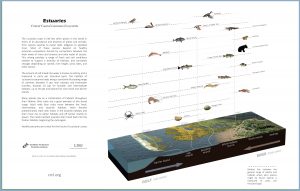Building Land in Coastal Louisiana:
Expert Recommendations for Operating a Successful Sediment Diversion that Balances Ecosystem and Community Needs
Sediment diversions have been recognized for decades as critical coastal restoration projects, and they have been included as a principle element of Louisiana’s Coastal Master Plan. Louisiana’s Coastal Protection and Restoration Authority (CPRA) is currently advancing two sediment diversions south of New Orleans for construction in 2020. These diversions are crucial investments in the state’s future as they will build and help maintain tens of thousands of acres of land over time and help support other restoration projects needed to protect communities, wildlife and industries across southeastern Louisiana.
Diversion Operations Expert Working Group:
Environmental Defense Fund (EDF), in coordination with Restore the Mississippi River Delta coalition partners, formed a Sediment Diversion Operations Expert Working Group to discuss and advance the latest science regarding how to maximize land-building through a sediment diversion while considering other effects. The group, comprised of 12 leading scientists with decades of experience working in coastal Louisiana, developed and shared operational recommendations with CPRA, the U.S. Army Corps of Engineers (USACE), other state and federal agencies, the larger scientific community, and communities and businesses with a stake in the operation of diversions. The group, along with 42 guest experts, participated in monthly meetings to provide information and recommendations based on experience and knowledge in their respective fields. They examined a variety of topics related to diversion operations, including:
- River Hydrodynamics and Sediment Loads
- Basin Geology and Land-Building
- Water Quality
- Wetland Health
- Fish and Wildlife
- Communities, User Groups and Socio-Economic Effects
- Operation Strategies
- Governance, Legal and Stakeholder Involvement
The working group used the Mid-Barataria Sediment Diversion as a case study to examine the above factors, with the assumption that a large-scale 50,000 to 75,000 cubic feet per second (cfs) diversion will be constructed into Barataria Basin. The working group selected the Mid-Barataria Sediment Diversion as a case study because it is furthest along in the Engineering & Design process.
| Rex Caffey | Natural Resource Economics | Louisiana State University |
| Jim Cowan | Fisheries | Louisiana State University |
| Dubravko Justic | Oceanography/Hydrology | Louisiana State University |
| Alex Kolker | Sedimentology | LUMCON/Tulane University |
| Shirley Laska | Social Sciences | University of New Orleans |
| Alex McCorquodale | Hydrodynamics | University of New Orleans |
| Earl Melancon | Oysters | Nicholls State University/Louisiana Sea Grant |
| Andy Nyman | Wildlife and Fisheries | Louisiana State University |
| Robert Twilley | Estuarine Ecology | Louisiana State University |
| Jenneke Visser | Vegetation | University of Louisiana at Lafayette |
| John White | Biogeochemistry | Louisiana State University |
| Jim Wilkins | Law/Policy | Louisiana State University |
Diversion Operations Expert Working Group Phase 2:
Building off the recommendations report, the Operations Expert Working Group created operational strategies to test some of the operational strategy recommendations using computer modeling and data analysis. Modifications to the membership of the OWG were made, specifically to expand expertise in dolphins, hydrologic modeling, food web dynamics and fisheries including:
| Ehab Meselhe | Hydrology Modeling | Tulane University |
| James Nelson | Food Web Dynamics | University of Louisiana at Lafayette |
| Steve Midway | Fisheries | Louisiana State University |
| Randall Wells | Dolphins | Chicago Zoological Society |
Operational strategies were developed to test how various flow rates and seasonal timing affects the ecological impacts to the system over 20 or 50 years. These effects were compared to a Future Without Action scenario, which assumes that a sediment diversion will not be constructed, implemented, or operated. Some of the concepts tested included reduced flows during key time periods for fisheries, focusing operations on the rising limb of the river when the amount of sediment concentrations in the river increase, and the need for a base flow through the diversion, which could keep the ecological system more stable and would prevent the water in the basin from becoming stagnant and more prone to the development of pockets of low-oxygen. The base flow was also needed as part of the adaptive management plan to counter the effects of droughts and salinity spikes on vegetation which could lead to sudden loss of large areas of wetlands.
Biological Analysis
Food web dynamics are complex and hard to model effectively but can be greatly affected by the various operational strategies and salinity changes within the basin. In general, the diversion would add nutrients into the system that would increase the overall productivity of the food web. However, due to the complex nature of fish and wildlife dynamics in relation to the operations of a diversion, the group decided it would be beneficial to identify the main organisms of the basin’s food web, possible responses to diversions, and variables that would impact their abundance and distribution in the basin. Species experts of the working group (Steve Midway, Earl Melancon, Jim Cowan, Jimmy Nelson, Alex Kolker, and Randy Wells) produced a report highlighting a number of groups and species that act as biological indicators and used best professional judgement to describe potential benefits and impacts on various life stages that may create a disruption in the food web dynamics.
This information from this work provides insight to the many possibilities of operating a sediment diversion and will help inform monitoring needs and a robust adaptive management plan that will be needed once a diversion is constructed.
For more information, please contact Natalie Peyronnin.
